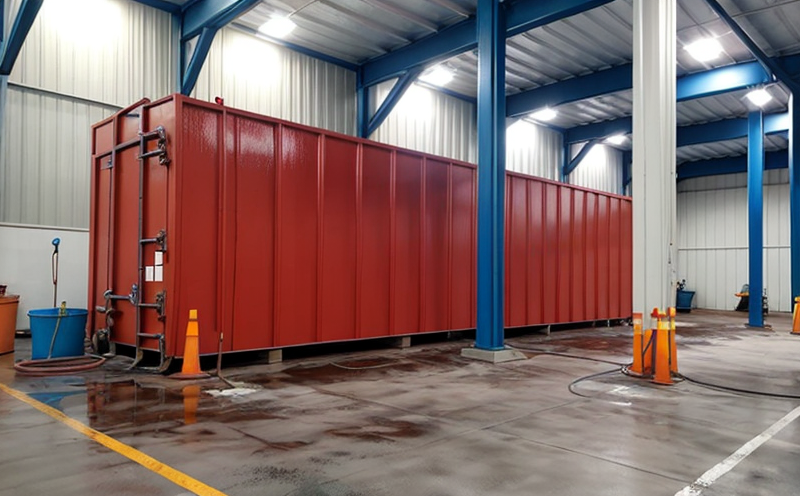ASTM D2247 Humidity Resistance Testing of Paint Films
The ASTM D2247 standard practice provides a method to evaluate the resistance of paint films to moisture under controlled laboratory conditions. This test is particularly important in industrial manufacturing and processing where coatings are used to protect various substrates from corrosion and environmental degradation. The primary goal of this test is to determine how well a paint film can withstand exposure to high humidity, which is crucial for ensuring that coatings meet the required performance standards.
The process involves exposing painted specimens to controlled humidity levels over an extended period. The specimens are typically steel panels coated with various types of paint films. After the exposure period, the samples are inspected for any changes in appearance or performance, such as blistering, softening, or loss of adhesion. This testing method helps quality managers and compliance officers ensure that industrial coatings meet the necessary durability standards.
The ASTM D2247 test is a critical step in the development and quality assurance processes for paints and coatings used in sectors like automotive manufacturing, aerospace engineering, construction, and marine applications. It allows R&D engineers to fine-tune formulations to enhance moisture resistance while maintaining other desirable properties such as adhesion, flexibility, and aesthetic appeal.
Compliance officers can use the results of this test to verify that industrial coatings comply with relevant regulatory requirements. For procurement teams, ASTM D2247 testing offers a reliable method for selecting suppliers whose products meet specific performance criteria. In addition to its role in quality assurance, ASTM D2247 is also used as part of research and development efforts aimed at creating new coating technologies that are more resistant to environmental factors.
The test procedure outlined in ASTM D2247 specifies the preparation of specimens, exposure conditions, and evaluation criteria. Specimens are usually 150 mm by 150 mm steel panels coated with a single layer of paint film, which is allowed to cure according to manufacturer specifications before testing begins.
| Test Conditions | Specimen Preparation | Evaluation Criteria |
|---|---|---|
| Humidity: 95% ± 3%, Temperature: 25°C ± 1°C, Duration: 72 hours | Cured paint film on steel panel with a thickness of approximately 60 micrometers | Visual inspection for appearance changes and adhesion tests to measure loss of adhesion |
The results from ASTM D2247 testing can indicate whether the paint film has maintained its integrity after exposure. If significant degradation is observed, it may suggest that further improvements are needed in the formulation or application process.
Understanding the implications of ASTM D2247 testing requires knowledge of both the technical aspects and broader industrial contexts where such tests play a vital role. By ensuring that industrial coatings possess adequate moisture resistance, manufacturers can extend the service life of products and reduce maintenance costs associated with premature failures due to corrosion or degradation.
Applied Standards
The ASTM D2247 standard is widely recognized for its accuracy in assessing paint film humidity resistance. It aligns closely with other relevant standards like ISO 16092, which also addresses the impact of humidity on painted surfaces. Compliance with these standards ensures consistency across different laboratories and enhances confidence in test results.
For quality managers looking to ensure product reliability, adherence to such internationally recognized practices is essential. By following ASTM D2247 guidelines, they can make informed decisions about material selection and process optimization that contribute to overall product performance and longevity.
Benefits
- Ensures compliance with industry standards for paint film durability.
- Provides data on the long-term performance of industrial coatings in humid environments.
- Aids in selecting suppliers who meet strict quality requirements.
- Serves as a valuable tool during research and development activities focused on improving coating properties.
By incorporating ASTM D2247 testing into their workflow, organizations can enhance their reputation for delivering high-quality products that stand up to rigorous environmental conditions. This translates directly into customer satisfaction and competitive advantage within the market place.
Use Cases and Application Examples
- In automotive manufacturing, ensuring that paint films used on exterior body panels can withstand harsh weather conditions including prolonged exposure to humidity.
- Aerospace companies using ASTM D2247 to verify the protective qualities of coatings applied to aircraft components exposed to extreme environments.
- Construction firms employing this test to assess the longevity of paints used in outdoor structures like bridges and buildings facing severe climatic challenges.
The table below summarizes some typical scenarios where ASTM D2247 testing is applicable:
| Industry Sector | Purpose |
|---|---|
| Automotive | Evaluating exterior paint durability in various climates. |
| Aerospace | Confirming the protective capabilities of coatings for aircraft components. |
| Construction | Assessing the resilience of paints used on outdoor infrastructure against environmental stressors. |
In these industries, the ability to predict how well a paint film will perform under different humidity levels is crucial for designing effective protective layers. ASTM D2247 provides this essential information by simulating real-world conditions in controlled laboratory settings.





